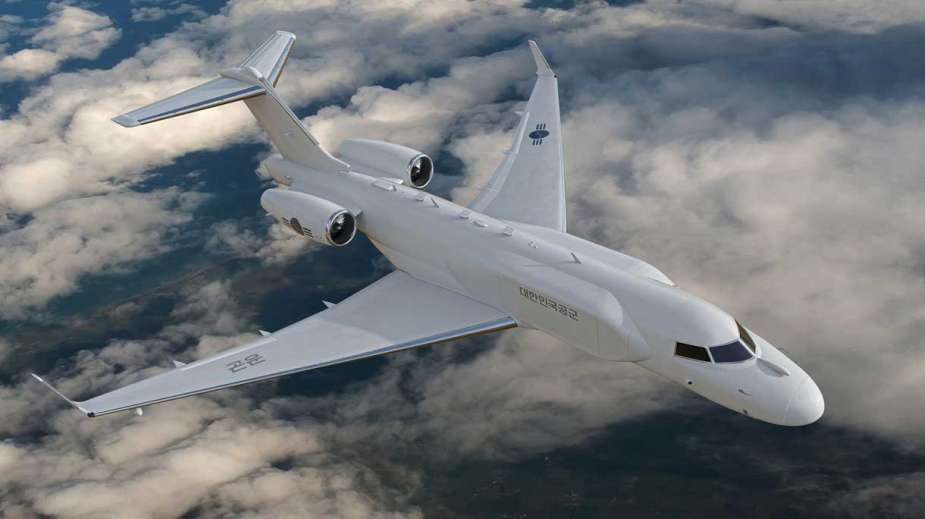Breaking news
South Korean Air Force strengthens air surveillance with L3Harris Bombardier's Global 6500 platform.
The South Korean Air Force, in collaboration with the AEW&C team spearheaded by L3Harris, has unveiled a sophisticated Airborne Early Warning and Control (AEW&C) solution. The heart of this AEW&C system is its incorporation of the combat-tested mission design, integrated into the advanced Bombardier Global 6500 platform. This integration ensures that the system is not only robust in capability but also cost-effective in terms of development and maintenance. The adoption of the Bombardier Global 6500, known for its high-altitude and long-range capabilities, signifies a major enhancement in the surveillance and defense capabilities of the South Korean Air Force.
Follow Air Recognition on Google News at this link
 L3Harris teamed with Korean industry to develop and deliver the next generation of survivable, high-altitude airborne early warning and control aircraft to the Republic of Korea Air Force. (Picture source: L3Harris)
L3Harris teamed with Korean industry to develop and deliver the next generation of survivable, high-altitude airborne early warning and control aircraft to the Republic of Korea Air Force. (Picture source: L3Harris)
Over the last twenty years, the Korea AEW&C team, which includes L3Harris, has successfully provided various clients with special mission aircraft. Their portfolio includes numerous Italian Air Force CAEW aircraft used in NATO missions and two Israeli Air Force CAEW aircraft for ongoing local operations. Remarkably, all these aircraft have maintained mission availability rates above 90%, highlighting the team's reliability and effectiveness.
L3Harris, a prominent player in defense technology, has a proven track record in delivering various key projects, such as the P-3CK revitalization, P-3C upgrades, RC-800 Baekdu programs, and specialized surveillance aircraft to the Republic of Korea (ROK).
The proposed AEW&C solution for the ROK Air Force combines a tried-and-tested mission system design with a modular open systems approach (MOSA) digital backbone. This integration with MOSA allows for cost-effective and swift upgrades to adapt to changing threats, operational methods, and interoperability needs. Opting for a business jet platform ensures lower operational costs compared to commercial derivative solutions, along with higher readiness rates and enhanced surveillance capabilities in terms of altitude and range.
At the core of this AEW&C solution is the L3Harris platform design, which utilizes Bombardier's Global 6500 high-altitude business jet. This platform, integrated with IAI/ELTA's advanced radar technology and artificial intelligence algorithms, is considered the world’s most advanced airborne battle management system. The Global 6500 offers superior specifications in altitude, speed, endurance, and cost-efficiency over existing AEW&C platforms.
Mark Kobussen, Managing Director of Strategic Collection & Targeting Programs at L3Harris, underscored the critical evaluation conducted for future special mission requirements for the Republic of Korea. The selection of the Global 6500 for this program was pivotal, particularly given its compatibility with other missions like Stand-Off Jammer and ISTAR.
A unique feature of this program is its strategic shift towards a predominantly Korean industry-led initiative after the delivery of the prototype. The first two aircraft are slated to undergo structural modifications in Texas before being moved to an ELTA facility in Israel for integration and radar testing. Korean Air has been involved from the onset and will be responsible for the engineering, in-country modifications, and testing activities for the subsequent aircraft, as well as for the program's maintenance.
Through partnerships with Korean Air, LIG Nex1, and Ace Antenna, and ongoing dialogues with additional Korean partners, the team aims to ensure comprehensive support for the aircraft and mission system equipment within Korea. Maintenance, obsolescence management, and future capability upgrades will be primarily driven by Korean industry specialists, with backing from the L3Harris team.
The Bombardier Global 6500 showcases a technically innovative design with a wingspan of 28.7 meters, a length of 30.5 meters, and a height of 7.8 meters. Its wings are specifically contoured for enhanced aerodynamic performance. The cockpit is equipped with the Bombardier Vision system, which includes four large display screens, a head-up display (HUD), and a combined vision system (CVS). Additionally, it features graphical flight planning systems, an airport moving map (AMM), and a MultiScan weather radar.
Performance-based navigational aids such as WAAS, LPV, and RNAV are integrated into the aircraft, along with Controller Pilot Data Link Communications (CPDLC) and high-speed satellite communications (SATCOM) technologies.
The Global 6500 is powered by two Rolls-Royce Pearl 15 engines, each producing 67.3 kN of thrust during takeoff. The aircraft can reach an initial cruise altitude of 12,497 meters and a maximum operating altitude of 15,545 meters. Its maximum cruise speed is Mach 0.90, and it has a range of 6,600 nautical miles. The takeoff distance for the aircraft is 1,942 meters, and its landing distance is approximately 682 meters. It has a payload capacity of 2,617 kg, a maximum fuel weight of 20,434 kg, a basic operating weight of 23,691 kg, and a maximum ramp weight of 45,246 kg. The maximum takeoff weight is 45,132 kg, while the landing and zero-fuel weights are 35,652 kg and 26,308 kg, respectively.


























